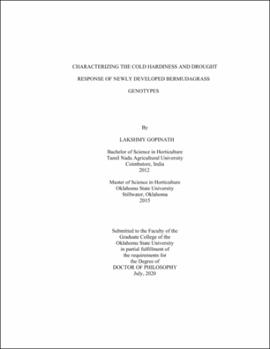| dc.contributor.advisor | Moss, Justin Quetone | |
| dc.contributor.author | Gopinath, Lakshmy | |
| dc.date.accessioned | 2021-02-22T22:24:03Z | |
| dc.date.available | 2021-02-22T22:24:03Z | |
| dc.date.issued | 2020-07 | |
| dc.identifier.uri | https://hdl.handle.net/11244/328602 | |
| dc.description.abstract | Bermudagrasses are often subjected to various abiotic stresses affecting their aesthetic quality, and functionality. Abiotic stresses, such as drought, and freezing are some of the common detrimental factors for bermudagrass growth in the transition zone. Utilizing freeze tolerant bermudagrass in golf courses or athletic facilities would decrease the cost associated with the re-establishment of turf lost to winter injury Therefore, developing bermudagrasses with better freeze or drought resistance is the priority of any bermudagrass germplasm improvement program. This study has evaluated the freeze and drought response of newly developed bermudagrass genotypes. The lethal temperature to kill 50% of the population (LT50) for the selected new genotypes was lower than that of industry standards 'Champion Dwarf' and 'Tifway' indicating higher freeze tolerance. Tahoma 31 consistently had the lowest LT50 value in this study. This research will help in prescreening genotypes prior to field evaluation and identifying genotypes with superior freeze tolerance to serve in future breeding efforts. In the drought response study, experimental genotypes from the University of Georgia had turf quality above 6 when subjected to 60 and 49 days of drought stress in 2017 and 2018, respectively. The superior performance of these genotypes could be due to their ability to extract water from the deeper soil profile during drought stress. However, when grown in a short 17 cm pot under controlled environment conditions, these genotypes dropped below the minimum acceptable turf quality within 6 and 9 days of drought stress in 2019 and 2020, respectively. The inconsistency in the performance of the genotypes in the restricted and unrestricted soil highlights the importance of soil depth to maintain turfgrasses without depending on supplemental irrigation successfully. The high correlation between the qualitative and quantitative measurements of drought response indicates their usefulness as relative drought resistance measurements. The wide genetic variations in bermudagrass response to drought and freeze stress, as discussed in this study, will serve as a valuable source for the advancement of bermudagrass breeding. | |
| dc.format | application/pdf | |
| dc.language | en_US | |
| dc.rights | Copyright is held by the author who has granted the Oklahoma State University Library the non-exclusive right to share this material in its institutional repository. Contact Digital Library Services at lib-dls@okstate.edu or 405-744-9161 for the permission policy on the use, reproduction or distribution of this material. | |
| dc.title | Characterizing the cold hardiness and drought response of newly developed bermudagrass genotypes | |
| dc.contributor.committeeMember | Martin, Dennis L. | |
| dc.contributor.committeeMember | Wu, Yanqi | |
| dc.contributor.committeeMember | Fontanier, Charles | |
| osu.filename | Gopinath_okstate_0664D_16841.pdf | |
| osu.accesstype | Open Access | |
| dc.type.genre | Dissertation | |
| dc.type.material | Text | |
| dc.subject.keywords | bermudagrass | |
| dc.subject.keywords | controlled environment | |
| dc.subject.keywords | drought response | |
| dc.subject.keywords | freeze tolerance | |
| dc.subject.keywords | two soil depth | |
| thesis.degree.discipline | Crop Science | |
| thesis.degree.grantor | Oklahoma State University | |
